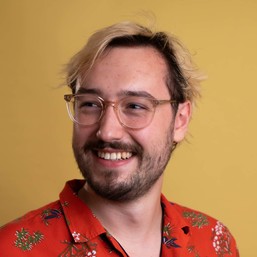
Is artificial intelligence the artist of tomorrow?
Artificial intelligence (AI) algorithms can do more and more and are becoming increasingly accessible, including in the art world. Folia speaks to AI and Computer Vision researcher Nanne van Noord. "There was also fear with the rise of photography, but traditional artists have not been replaced."
At the end of the summer, there was a stir online surrounding American Jason Allen. Allen won in the digital art/digitally manipulated photography category of the Colorado State Fair with the help of the artificial intelligence (AI) algorithm Midjourney. This generated varying reactions: people were angry, outraged, happy, but also concerned. Where is this development headed and what does it mean for artists of the near future? Folia sat down with university lecturer and AI scientist Nanne van Noord to find out more.

Van Noord specializes in the intersection between computer vision - the application of AI to image - and visual culture. This involves visual culture in the broadest sense, from painting to films and comic books. Van Noord says: "An example is iconic photographs - there are, of course, processes that determine how a photograph becomes so well known. Knowledge of those processes can then tell you something about how to analyze photographs with AI and what that means for AI development."
The AI algorithms that create artwork do it by collecting and analyzing billions of images and text from the Internet. A model such as Midjourney generates an image based on a phrase the user enters. "The model is taught this by 'looking' at an awful lot of images and associated text. So it then learns connections between certain words and certain visual images."
If someone creates such a work of art with AI, who is the artist?
"In a way, it depends on the balance of the specific 'collaboration,' but ultimately such an algorithm is just a tool to create art. There are limits, but, for example, during the rise of photography there was also a lot of resistance to it. AI art is not trivial; a significant amount of time and effort go into learning to work with such algorithms to create a beautiful work. In that, it does resemble photography, which is also more than pushing a button. It also reminds me of found art, like the banana stuck to the wall in Miami. In a way you find the work, followed by selection and manual adjustments."
So will the traditional artist be replaced by a AI artist in the future?
"That fear was also there with photography and digital art, and traditional artists have not been replaced, either. There is still appreciation for hand-painted paintings. A more AI-related development is the rise of translation algorithms, but they haven't replaced translators, either. Texts must still be checked for tone and nuance. It is plausible, though, that the price per translation or work will go down so more work can be done in the same time."
What direction do you think the use of these AI models will take?
"What I hope is that AI developers can give users more control over these kinds of algorithms. In that case, I expect it to become more of a creative tool. Increasing control probably makes it less accessible, but then again, that allows AI art to create its own expertise. Maybe someone who can't draw very well but has good ideas can then create their own comic book, for example."
Will you also use these models in research?
"Recent developments sparked my interest in using artificial AI algorithms for research, especially to do research on 'cultural memory' within the models. For example, cultural memory is when I ask a random person on the street what the most famous painting in the Louvre is, almost everyone will say the Mona Lisa. If I pose this question to a AI model that creates art, I will get a picture that looks like the Mona Lisa. I am curious to know where that boundary is and how we can control it. If we can give AI models more cultural memory, the outcomes will probably be more in line with user expectations. Now it matches the cultural memory of a huge Internet database whose contents we are unsure of."
So what is that cultural memory of such a database?
"One of the biggest drawbacks of data collection and connecting data is that the Internet is the biggest data source. In my opinion, the Internet is not a good reflection of society. Because of its anonymity, there are many more negative expressions on the Internet.
Such prejudices and stereotypes can also end up in the cultural memory of such a model. It might then give a distorted picture of reality through the lens of the Internet collection.
Own creation
To put the conversation with van Noord into practice, Folia created a work of art with him, seen at the top of the article. The AI Stable Diffusion was used for this with the following text input: a painting of an artist in their studio with a window overlooking the city with an easel and paint in the corner.

